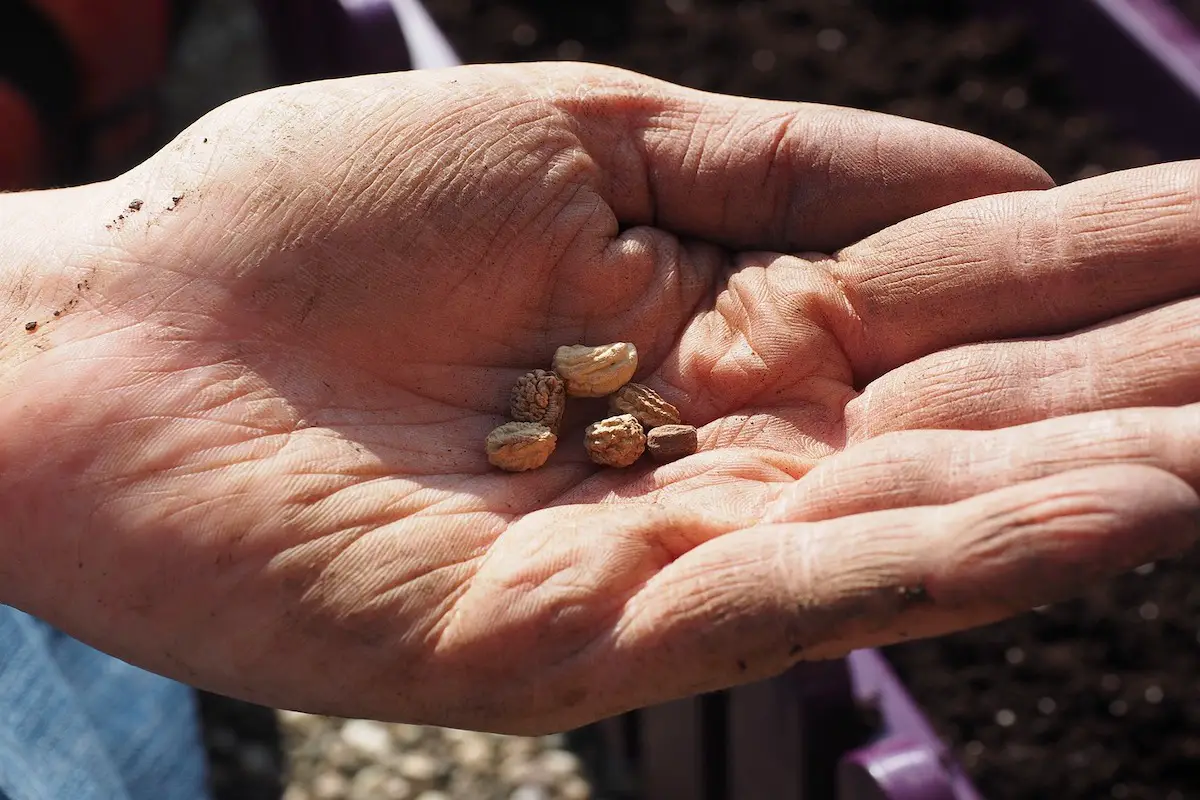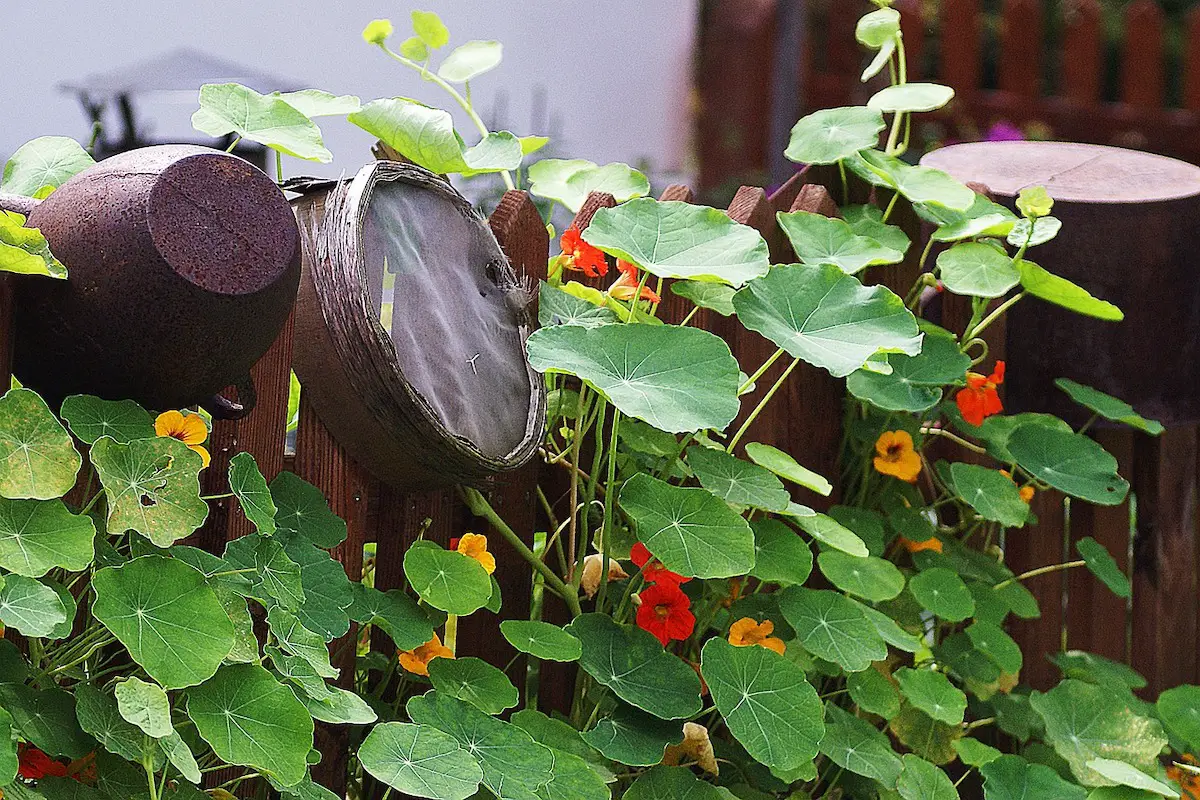As gardeners, we’re working toward creating a naturally balanced ecosystem that allows for minimal labor and inputs. Companion planting can be an excellent tool for such a goal. Nasturtium has attributes that lead it to function well in plantings near many fruits, vegetables, and flowers. We have a guide for nasturtium companion plants outlined here!

Nasturtium Companion Plants
Nasturtium is one of my favorite flowers in the garden because of its beauty and versatility. It is a simple, edible, and medicinally valuable plant to grow. You’ll often see it grown with fruit crops, in vegetable gardens, and as an ornamental flare. It requires little nutrition to thrive, so it doesn’t take away from some of your heavy feeders like melons and tomatoes.
What is Companion Planting?
Companion planting is all about enhancing the health of your garden’s ecosystem. It involves placing plants in proximity to others in order to create a mutually beneficial relationship or a one-sided benefit for a particular plant.
The Old Farmer’s Almanac categorizes these potential benefits as such:
Shade– Larger plants can be used to cast natural shade on smaller shade-loving or tolerant plants.
Support– Tall, sturdy crops can act as living support for vining or sprawling crops. I would also add that taller, bushier plants can be used for “support” in the form of wind protection.
Better Health– A plant can absorb substances from the soil, changing soil biochemistry to help other plants.
Soil Benefits– Specific plants require certain nutrients to grow. Plants can be grown together based on available nutrients and some will bring up nutrition from deeper levels of the soil for plants with shallow roots can access. A common use is to fix nitrogen in the soil.
Weed Control– Plants can be used as ground cover to lower weed competition. In that, you are producing more food, pollinators, or plants in any given space. Ground cover crops also help prevent erosion.
How to Grow Nasturtiums- The Basics
Nasturtium plants fall into the Tropaeolum genus and can be found as both annual and perennial flowering species. They are native to South and Central America where they continue to thrive as a garden staple. Found as both vining plants (Tropaeolum majus) and bush plants (Tropaeolum minus), they can be grown in containers, in-ground beds, or raised beds with ease.
You can grow your plants from seed or nursery starts. Nasturtiums are reliably started from seed, and their large seeds make them easy to sow at about ½ inch deep indoors or in the garden. They prefer full sun (6-8 hours) but are shade tolerant (3-6 hours of sun). They like to be shielded from the midday summer heat! Nasturtiums grow well in soil that is not overly rich in nutrients and not overwatered…they’re one of those lower-maintenance plants. Plant your nasturtiums in that area of your garden with less desirable soil!

Using Nasturtiums as Companion Plants
Nasturtiums are considered a top companion plant, as they are excellent for repelling certain garden pests and providing a natural canopy to protect bare ground and suppress weeds. They do so all while producing edible flowers, leaves, and seedpods! I love utilizing nasturtiums most for their ability to fend off damaging pests; as a bonus, I get to add some peppery blooms to my fresh garden salads.
While the idea of a “trap crop” might seem counterintuitive, attracting pests such as aphids to your nasturtiums will in turn attract more natural predators to feed off of the rest of your garden pests.
Cucumbers & Melons
Many people report nasturtiums as improving the quality and flavor of their cucumbers and melons when planted in close proximity. But, besides that, nasturtiums both attract and repel pests such as whiteflies, cucumber beetles, squash beetles, and aphids away from your fruiting plants.
When planting nasturtiums close to cucumbers or melons, think about using a vertical trellis for the cucumber and melon plants so they are not competing for ground space. I love growing cucumbers and melons vertically anyway to save on space and keep their fruits off the soil. The nasturtiums will act as a gorgeous, sprawling weed barrier in this scenario.
Fruit Trees
This is a magnificent symbiotic relationship in nature. Fruit trees provide afternoon shade for the nasturtiums while attracting additional high-flying pollinators like hummingbirds, breaking up compact soil, and holding moisture in their deep root systems. Nasturtiums work to repel pests such as the codling moth from the generous fruiting trees while attracting lower-flying beneficial insects and pollinators such as bees and wasps.
Nightshade Plants
Nightshade plants include tomatoes, potatoes, eggplant, and peppers. Nasturtiums are adept at providing ground cover for these plants all while acting as a trap crop for aphids and a repellent for pests such as the potato beetle.
Lettuce & Greens
Nasturtiums most prominently work to attract aphids away from your greens, but they also help shade the ground and hold in moisture for those heat-sensitive leafy vegetables.
Brassicas
As with nightshade plants, many brassicas (I suggest cauliflower, kale, brussels sprouts, broccoli, and cabbage) provide an understory for nasturtiums. Nasturtiums benefit the brassicas by acting as a trap crop for aphids and a repellent for blackflies, cabbage worms, squash beetles, and whiteflies (all common pests for brassicas). They can help lower populations of undesirable insects on your thriving vegetables.
Carrots, celery, radishes, marigolds, and wildflowers are also recommended as companions to the bold & magnificent nasturtium.

Where Not To Use Nasturtiums
Don’t use nasturtiums in places where they will have to compete with other sprawling plants for space. You can trellis your vining nasturtiums as an alternative!
Like many other plants, Nasturtiums will not benefit from being planted near fennel. Fennel is an allelopathic plant that secretes allelochemicals that will suppress the growth of many neighboring vegetables and plants.
*If you have some curiosity about the general use of companion plants in the garden, here is a recommended book to guide you in your research and learning!
FAQs (Frequently Asked Questions)
Nasturtiums produce nectar and fragrance that attract beneficial insects like ladybugs, bees, and predatory beetles. These insects help control harmful pests in the garden.
Nasturtiums thrive in well-draining soil of moderate fertility. They are adaptable to various soil types but prefer slightly alkaline conditions.
Nasturtiums are not considered invasive. They are annual plants, and while they may self-seed, they are easily managed and do not typically become problematic.
More On Growing Flowers
Flowers are essential to any garden. Let us help you add beauty, biodiversity, and pollinators to your space.


Leave a Reply